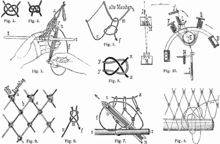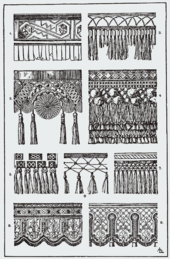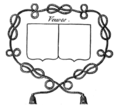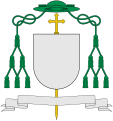Knot (tying)
A node ( ahd chnodo , MHG knode nodular thickening ') is in the knots an entanglement or intertwining of yarn , string, band , rope , cordage , cloth or similar flexible fabric , sometimes a chain which is wound in a certain form, wrapped , tied or knotted. The turns of the knotted material pinch under tension, increasing the friction and reducing or preventing sliding. According to the way the winding course runs, node types can be distinguished from one another.
It should be noted that a knotted rope can no longer be loaded according to its original tensile strength , because the knot becomes a weaker point in the course of the rope. The remaining reduced tensile strength is called the knot strength . In addition, the rope friction on a solid object can reduce the load capacity.
Knots are used for different purposes and in very different areas of application, which is why there are often several names for the same type of knot. If one wants to define the entanglement forms with the term knot in more detail, three meanings can be defined:
- in the broadest sense any kind of entanglement, including forms of connecting several ends, pieces and objects, see above
- Knots when sewing , weaving , braiding , for macramé , plating, etc. a.
- Connecting knot to tie two lines together
- Mooring knot ( stek or stitch ) to tie a line to objects
- Clamp knots to tie one line to another
- Splice to tie the fibers of a line around
- in the narrower sense a local loop that is tied into a short piece of the line
- in the narrowest sense the form of a local thickening
- Stopper knot , prevents it from going through
- Knots for a better grip
The knots has a long list of nodes with climbing knot, square knot , fishing knots , fire brigade knot , tie knots and also describes the tying knots.
history
Stone Age and Antiquity
Humans have been using knots for half a million years. Even gorillas and other monkeys knot blades of grass when building nests.
As early as the Stone Age there were people who, as gatherers and hunters, later as settlers and fishermen, tied snares and nets in order to catch animals and fish. The axes of the Stone Age were held together by knotted intestines, as were the pile dwellings with sinews and ropes. The simple overhand knot was used to tie together everyday objects. The fillet knot (an overhand knot tied around a guide) for tying the nets developed from it. To hunt with a bow ( Paleolithic , 30,000 to 10,000 BC), the bowstring had to be securely attached. The Ötzi glacier find (around 3340 BC in the Neolithic Age ) shows simple knots, overhand knots and square knots on his equipment.
Antiquity
The oldest tradition of decorative knots comes from the Assyrians from antiquity (900 to 609 BC). Reliefs carved in stone showed tunic-like robes, tunics and horse blankets. They are decorated with tightly linked fringes and thick tassels .
In the first century, the Greek physician Heraklas described sixteen surgical knots .
In ancient times, certain knots were even given magical powers. Homer mentioned in Canto 8 of the Odyssey that Odysseus " tied up valuable gifts from Alcinous and the Queen with a rope, which he secured with a magical knot in the artistic manner of Kirk ."
The Roman scholar Pliny the Elder (approx. 23–79 AD) claimed that the Hercules knot would heal wounds faster that were closed with it.
After 756, the Moors brought Arab influences in knotting technology to Europe ( Córdoba / Spain).
With the crusades (1096 to 1270) up to the late Middle Ages , the relatively simple fringes of the Egyptians and Assyrians developed into artistic knotted edges . The old Inca empire (1250 to 1781) knew " Quipu ", a knot script which transmitted statistical records in the decimal system .
seafaring
The third major influence came from Christian seafaring . A large number of " Schifferknoten " were used for a wide variety of purposes. In their voyages, which often lasted for months, the seafarers began to knot, in addition to their well-known utility knots, in their free time with yarn and rope according to patterns that they had seen in the Orient. They decorated their ships with artfully knotted bells, knotted bottles and much more. Often these works were of no practical value, they were more for decoration. This "knot art" is cultivated as fancywork, plating and macrame.
Modern times
New knots are continually being invented for today's requirements, for example the Zeppelinstek or the snap-hook knot . In the 1980s, Scoubidou became known, which was widespread among young people in 2004.
The Zeppelinstek or Zeppelin knot is one of the "youngest" knots, which has been recognized in the professional world.
With Rainbow Looms , various objects such as ribbons, bracelets or large-scale links or interweaving using rubber rings are made.
Applications
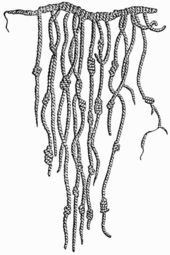
font
Knots were also used as writing in the past . The Incas used the knot script Quipu . Farmers and millers used knots as an aid to counting ( miller's knot ).
Jurisprudence
The hangman's knot on the gallows was used to execute a convict. In the Middle Ages, a document knot was tied in the straps of the document when a contract was concluded . The number of knots proved how many men were involved in the conclusion of the contract and agreed with the content of the contract. The “knot” was therefore considered a witness or witness in the court.
heraldry
In coats of arms the " love knot " served as a coat of arms figure in love cords or love ropes, which in the 17th century (France) served as fashionable creations and decorations. The love knot is also known as the "widow's rope".
Even today they can still be found in the badges of Scottish clans.
Job and sport
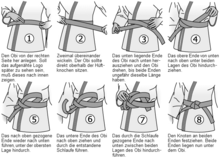
Knots are used by many professional groups and in many sports:
- Sailors and sailors , divers ,
- Scouts , aid and rescue organizations , fire brigade ,
- Surgeons ,
- Mountaineers and climbers ,
- Angler ,
- Japanese samurai developed their own bondage art ( Hojōjutsu ) in the Middle Ages to make prisoners immobile and able to be transported away. Today the complicated knotting techniques from the Hojōjutsu are still taught in the Japanese police . Nodes are known under different names in the various groups.
everyday life
- Cords and knots are increasingly being replaced by quick-release fasteners, zip fasteners , Velcro fasteners , cable ties , and parcel tape .
- In everyday life, knots are used to tie aprons , belts , shoes (with a bow and sometimes with double knots ), for packages and for bundling goods for transport.
Hidden knots
- Almost inconspicuously there are special knots called "winding and Ursus knots" in the knot network of wild fences .
- The handles ( tsuka ) of the Japanese samurai swords are made more handy and artistically designed with special knots . The conclusion is formed by a Ura or Omote knot .
Art and fashion
- In fashion, knots are used for decorative purposes.
- The best known are probably the tie knots .
- On hats is Hutschnur known.
- With hairstyles, there are top knots . The Heracles knot is popular with antique and modern jewelry .
- In craftsmanship, knots are used to knot carpets and weave fabrics. A carpet consists of up to 1,000,000 knots per square meter, the quality increases with the number of knots per square meter.
- Macrame , plating , lace-making , knitting , weaving and crocheting are other techniques in handicrafts in which knots play an important role.
- In the military, there are elaborate decorations on uniforms, such as the rifle cord , armpit cord or catch cord .
Knot on epaulettes
Shoulder piece of a colonel of the NVA (GDR)
sex
In the bondage scene, fixing or decorative knots are used for bondage and other sexual practices .
magic
Tricks for entertainment can also be demonstrated with knots. Such knot tricks are used especially in magic tricks . A meaningful, practical application is usually impossible in everyday life.
science
Nodes are u. a. for the analysis of macromolecules such as proteins and DNA of interest. Science has been concerned with the mathematics and physics of knots for centuries. The knot theory deals with the topology of nodes and answering of questions serves as which nodes are mathematically equivalent, d. H. can be converted into one another without having to be cut up. The knots , however, is concerned with the production, differentiation and application of nodes.
Given the complex interplay between topology and mechanics , the properties of elastic nodes are difficult to determine. Researchers at the Massachusetts Institute of Technology developed a model in 2019 to predict node stability. In doing so, they consider the number of crossings, the twists and the opposing strands. To test their theory, the researchers made experiments with photonic fibers that change color when pulled.
Association of knot specialists
Under the International Guild of Knot Tyers , an association of like-minded people from all classes and professions was founded in London in 1982 . From beginners to specialists with an interest in knots, the exchange takes place in forums and member magazines. Due to the constant development of synthetic fibers , the area of application of knots is constantly being expanded and updated.
Terms
Fixed end
The fixed end is the long part of a line on which the load hangs or pulls, for example a crane rope or a lasso, or on ships a mooring line, an anchor line, a sheet, a halyard. In the classic sailor's language one speaks of the "fixed" or " standing part ".
Loose end
The loose end is the short part of a line with which the knot is tied or tied and which hangs unloaded from the finished knot. The loose end on the finished knot should always be at least 3 to 5 times as long as the diameter of the line. In the classic sailor's language one speaks of the " loose part "; there the “end” has the meaning of a whole piece of rope.
Idioms
- A Gordian knot is a difficult problem
- "Having a knot in my throat" = I'm not comfortable with it.
- "Tie a knot in the handkerchief / ear" = a reminder
- "Find a knot" = Something is wrong here.
- "Cut a knot" = separate something forcibly / without hesitation instead of laboriously untying it
- "The knot has opened / burst" = a solution has been found, a blockage has been resolved, the matter has been understood
- “ Cable tangle ” = a mess or a knot in cables that is difficult to solve
- " Untangle a ball " = untangle a tangled or multiple knotted rope or yarn (in the figurative sense: dissolve confused thoughts).
See also
literature
- Clifford Ashley : Ashley Book of Knots . Over 3800 knots. How they look like. What they are used for. How they are made. Special edition. Edition Maritim, Hamburg 2005, ISBN 3-89225-527-X .
- Raoul Graumont and John Hensel: ENCYCLOPEDIA OF KNOTS AND FANCY ROPE WORK. Cornell Maritime Press, Inc. Cambridge, Maryland. (1933-) 1977 (4th edition) More than 3668 knots in b / w pictures, ISBN 0-87033-021-7 .
- Geoffrey Budworth: Knots - the practical handbook. Delius Klasing, Bielefeld 2009, ISBN 978-3-7688-2538-2 .
- J. Tom Burgess: The practical knot primer. Knots, loops, splices . 7th edition BLV, Munich and Vienna 1996, ISBN 3-405-12969-9 .
- Kai Lund: BÄNDSEL LINEN TROSSEN, and how to use it . Delius Klasing, 1972, ISBN 3-7688-0140-3 ; (Title of the Danish original edition: KNOB OB SPEJS by Borgens Forlag AS, Copenhagen.)
- Erich Sondheim: Knots splicing Takeln , Klasing + Co, 1975, ISBN 3-87412-009-0 .
- Arved and Conrad H. v. Sengbusch: Working with TAUWERK, arts and crafts, practical, nautical , Topp Frech-Verlag Stuttgart 1978, ISBN 3-7724-0212-7 .
- Clemens Creynfeld: Knots from AZ , Edition moses Verlag, 1999, ISBN 3-929130-57-2
- JC Turner, Peter van de Griend ′ ′ History and Science of Knots ′ ′ World Scientific Publishing Co. Pte. Ltd. Singapore, New Jersey, London, Hong Kong 1996, ISBN 981-02-2469-9 .
Web links
- for an overview with German names for the category categories, see Commons: Subcategories of Nodes
- Knot dictionary "Gordian knot" - learning to knot made easy.
- Scoutwiki: Knots and frets in pioneering technology
- Good instructions verschiedenster node (Engl.)
Individual evidence
- ↑ NODE . In: Jacob Grimm , Wilhelm Grimm : German Dictionary . Hirzel, Leipzig 1854–1961 ( woerterbuchnetz.de , University of Trier).
- ↑ Clifford Ashley: Ashley Book of Knots .
- ↑ Which knot holds best? In: spectrum. January 30, 2020, accessed February 1, 2020 .
- ^ Christian Tröster: Museum guide: Internationales Maritime Museum Hamburg . ( limited preview in Google Book Search [accessed April 17, 2020]).
- ↑ General Encyclopedia of Sciences and Arts . S. 147 ( full text in Google Book Search [accessed February 1, 2020]).
- ↑ Macrame as an art and hobby , p. 17
- ↑ Miller's knot as quantity and type identification
- ↑ Counting node of the miller
- ↑ Source: women's coat of arms
- ↑ Love knot (BILD)
- ↑ Charles Boutell: The Handbook to English Heraldry . ( HTML - Bourchier Knot (No 219), Bowen Knot (No 220) and many more).
- ↑ Wrap and Ursus knot image
- ↑ Making carpets
- ↑ Physics: Researchers develop theory about the strength of knots. In: time online. January 5, 2020, accessed January 12, 2020 .
- ^ Vishal P. Patil, Joseph D. Sandt, Mathias Kolle, Jörn Dunkel: Topological mechanics of knots and tangles . In: Science . tape 367 , no. 6473 , January 3, 2020, p. 71-75 , doi : 10.1126 / science.aaz0135 .



